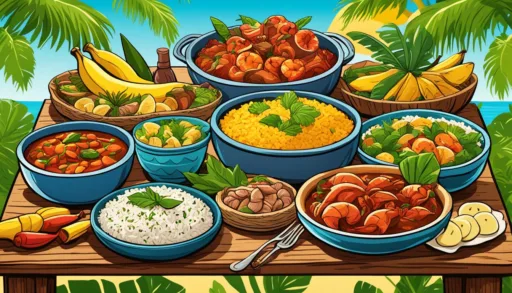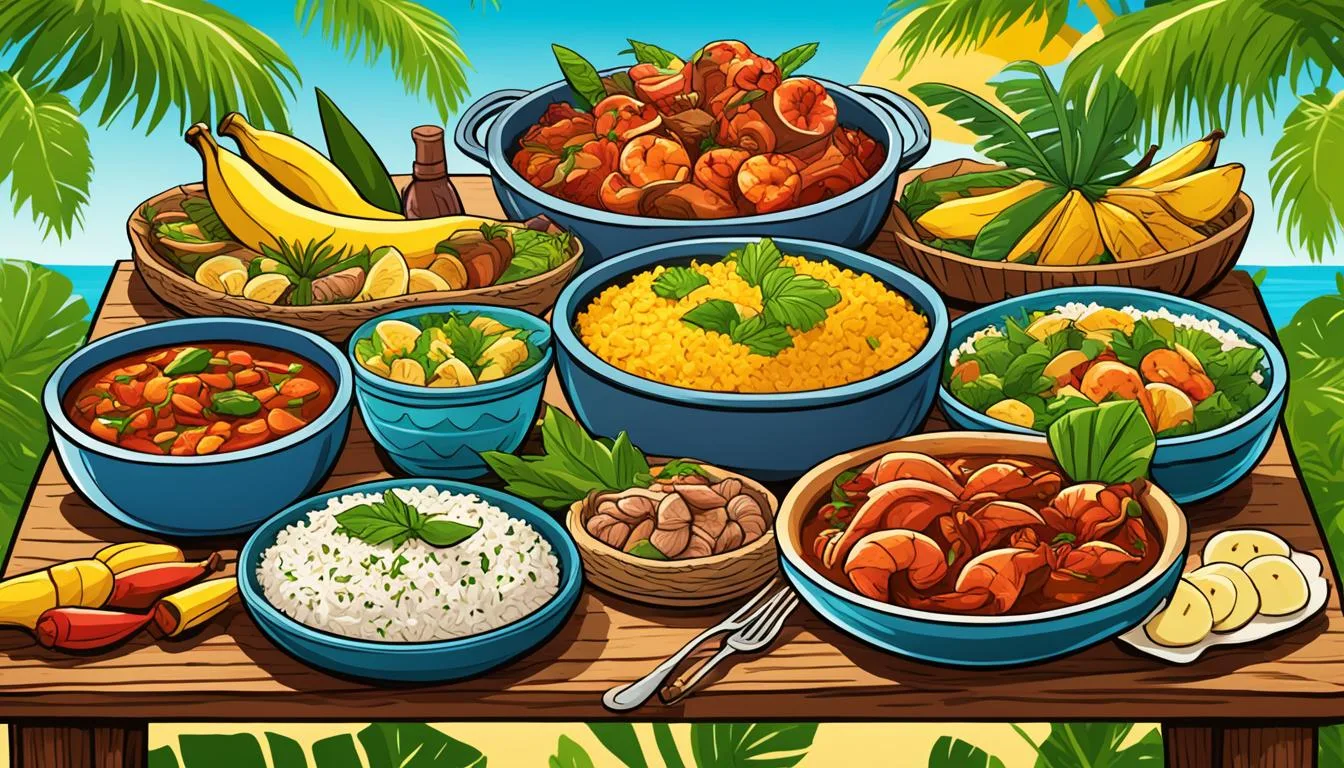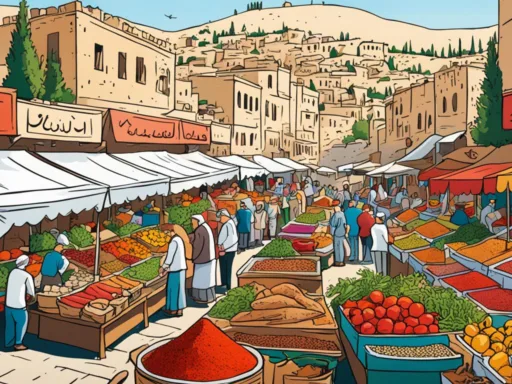A lesser-known fact about Guinea-Bissau could tantalize the taste buds of any curious food lover—is that this small West African nation is the world’s fifth-largest exporter of cashews. But there’s more to this country than cashews. The local cuisine in Guinea-Bissau is a veritable mosaic, blending West African, Portuguese, and indigenous influences into an array of traditional recipes Guinea-Bissau that offer both complexity and heartwarming simplicity. From the rich and savory flavors of the Atlantic’s bounty to the communal pleasure found in a bowl of cachupa, the Guinea-Bissau Food Guide opens a window into a culture where every meal narrates a part of its story.
Key Takeaways
- Guinea-Bissau’s gastronomy is a cultural tapestry woven from local, Portuguese, and West African threads.
- Staple dishes such as Jollof rice and cachupa not only nourish but also celebrate Guinea-Bissau’s communal values.
- Fresh seafood is a testament to the country’s idyllic coastal setting, influencing many of the top dishes to try in Guinea-Bissau.
- Traditional recipes in Guinea-Bissau often incorporate tropical fruits and local ingredients like cashews, indicative of the nation’s rich natural resources.
- The enduring presence of Portuguese spices and cooking techniques is a nod to the country’s historical narrative through cuisine.
- Street foods and treats like Pasteis de Massa Tenra offer authentic food experiences that are both accessible and delightful.
Guinea-Bissau Food Guide: A Gateway to West African Flavors
The rich tapestry of Guinea-Bissau food culture is both an odyssey through history and a canvas for the senses. As adventurers in taste seeking authentic food experiences in Guinea-Bissau, we open the gateway to a world of distinctive West African flavors.
An Introduction to Guinea-Bissau’s Gastronomy
With every meal, Guinea-Bissau offers a story—a blend of indigenous traditions with Portuguese influences, each recipe narrating the country’s past, present, and future. Top dishes to try in Guinea-Bissau are more than just nourishment; they symbolize the communal spirit and the harmonious fusion of land and sea.
Seafood Staples: The Coastal Influence on Local Cuisine
The Atlantic coast drapes the cuisine of Guinea-Bissau with an abundance of seafood. Grilled fish and succulent shrimp are the stars, reflecting the local’s adeptness at harnessing the gifts of the ocean. Deeply rooted in coastal life, these staples are an everyday homage to the country’s geography—an edible echo of the waves.
Rice-Based Dishes: The Backbone of Guinea-Bissau Cuisine
Rice does not merely fill a bowl in Guinea-Bissau—it serves as a base note for a symphony of flavors, most notably captured in the heralded Jollof rice. Celebratory feasts and humble family dinners alike are incomplete without the presence of this culinary cornerstone, making it one of the top dishes to try in Guinea-Bissau and an integral part of the food story every visitor should experience.
Diving into the Cultural Significance of Jollof Rice
The vibrant dish of Jollof rice is not just a staple must-try dish in Guinea-Bissau; it’s a symbol of festivity, unity, and the rich tapestry of West African cuisine. This beloved meal transcends borders, signifying the shared cultural significance that extends throughout the region. Let’s explore the roots of this iconic dish, its place in cultural celebrations, and how it varies across West Africa.
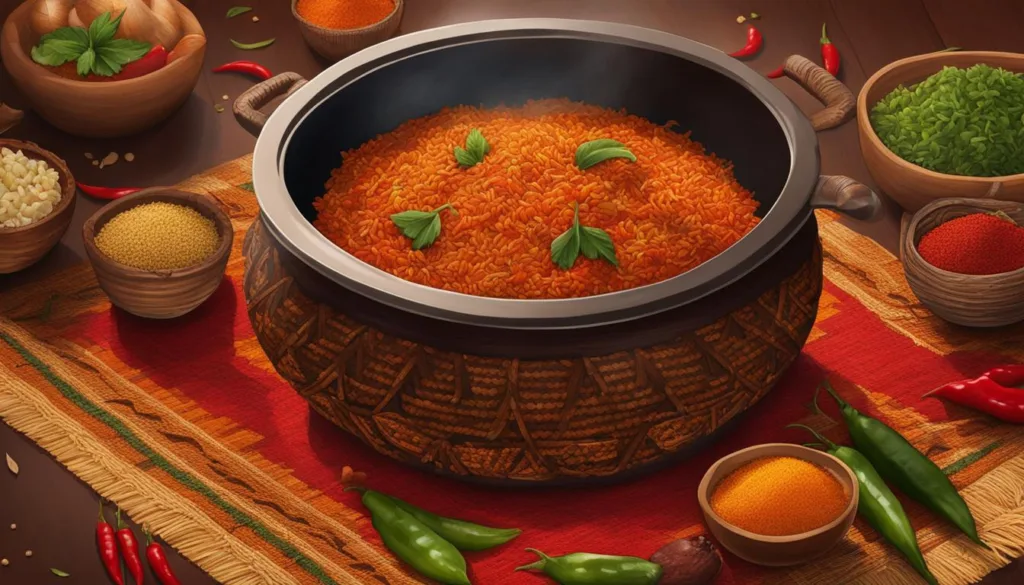
The Origin of Guinea-Bissauan Jollof Rice
The story of Jollof rice begins in the ancient Wolof Empire, present-day Senegal and The Gambia, influencing countries like Guinea-Bissau where the dish is a culinary highlight. The traditional preparation involves simmering rice in a savory tomato sauce infused with onions, peppers, and a blend of spices that create its distinctive flavor and aroma.
Celebrating with Jollof: Festivals and Everyday Enjoyment
In Guinea-Bissau, Jollof rice is more than just food; it’s a centerpiece at weddings, religious festivals, and family gatherings. Like the intricate weaves of fabric in traditional clothing, the layers of flavors in Jollof rice bond communities, symbolizing a collective heritage and the joy of shared experiences.
Jollof Rice Across West Africa: Variations and Shared Heritage
While Jollof rice is a unifying feature of West African cuisine, each nation imparts its own unique touch. Nigeria’s version is notably spicier, while Ghanaian Jollof boasts a smokier taste. Despite these differences, the dish remains a shared cultural touchstone that resonates with the culinary heart of every West African country.
For anyone eager to delve into the flavors of West Africa, understanding the cultural significance of Jollof rice offers insight into the region’s history, its people’s celebrations, and the diverse culinary traditions that make it an unforgettable food destination.
Authentic Recipes from Guinea-Bissau
Dive into the heart of Guinea-Bissau’s local cuisine with these cherished traditional recipes. Each dish offers a taste of the nation’s culinary diversity and a connection to its rich cultural tapestry.
Preparing Traditional Caldo de Peixe (Fish Stew)
A staple in Guinea-Bissau food guide, Caldo de Peixe is a flavorful fish stew, savored for its delicate balance of fresh catch and aromatic spices. This beloved meal epitomizes the essence of traditional recipes from Guinea-Bissau. Below you will find a table rich with the necessary ingredients and steps to create your own Caldo de Peixe, bringing a piece of Guinea-Bissau to your kitchen.
| Ingredient | Quantity | Preparation |
|---|---|---|
| Fresh Fish | 2 lbs | Clean, gut, and cut into portions |
| Onions | 2 large | Dice finely |
| Tomatoes | 4 medium | Crush and peel |
| Garlic Cloves | 4 | Mince |
| Bay Leaves | 2 | Add whole for flavor |
For the perfect Caldo de Peixe, simmer ingredients gently until the fish is flaking apart, then serve hot with a side of aromatic rice.
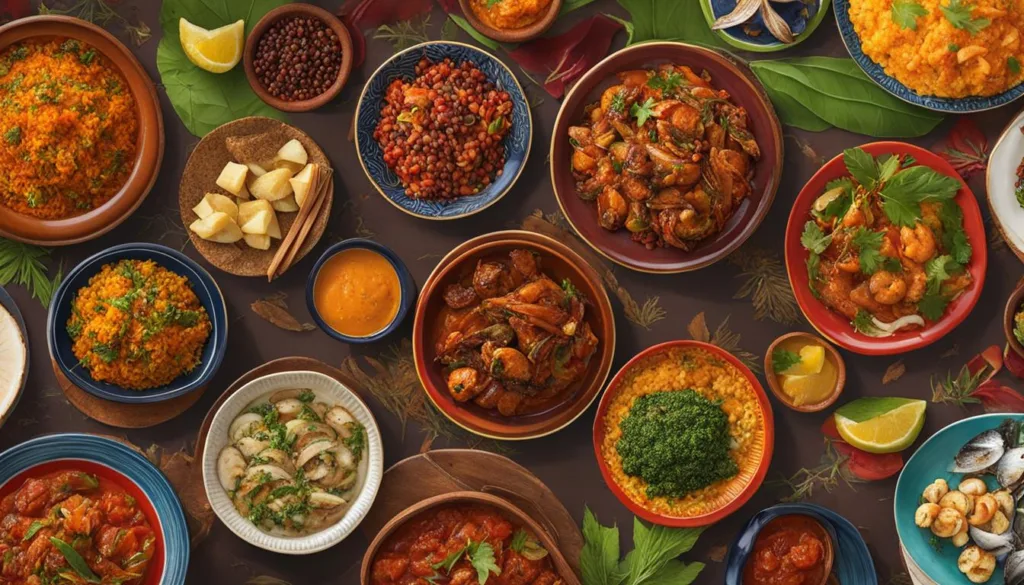
The National Dish: How to Make Cachupa
Cachupa, the national dish of Guinea-Bissau, is a hearty stew that encapsulates the history of local cuisine in Guinea-Bissau. Reflecting the country’s use of its abundant resources, cachupa is a satisfyingly complex mixture of corn, beans, and a variety of meats.
- Begin by soaking corn and beans overnight.
- Prepare your selected meats – typically chicken, chorizo, and pork.
- Slowly stew the base ingredients, allowing flavors to marry.
- Add local vegetables like manioc and sweet potato for authenticity.
- Enjoy a community-centric dish that symbolizes togetherness and heritage.
Cachupa is often shared among friends and family, reflecting the communal nature of dining in Guinea-Bissau.
Exploring Must-Try Dishes: A Culinary Checklist for Guinea-Bissau
Guinea-Bissau’s rich culinary landscape offers an array of flavors that reflect the country’s vibrant food culture. For travelers eager to delve into the local gastronomy, certain top dishes to try in Guinea-Bissau stand out as absolute essentials. These dishes not only tantalize the taste buds but also offer a window into the nation’s heart and soul, making them must-have experiences for any food enthusiast. Below is a curated checklist to guide you through the best food spots Guinea-Bissau has to offer, ensuring an authentic and unforgettable taste journey.
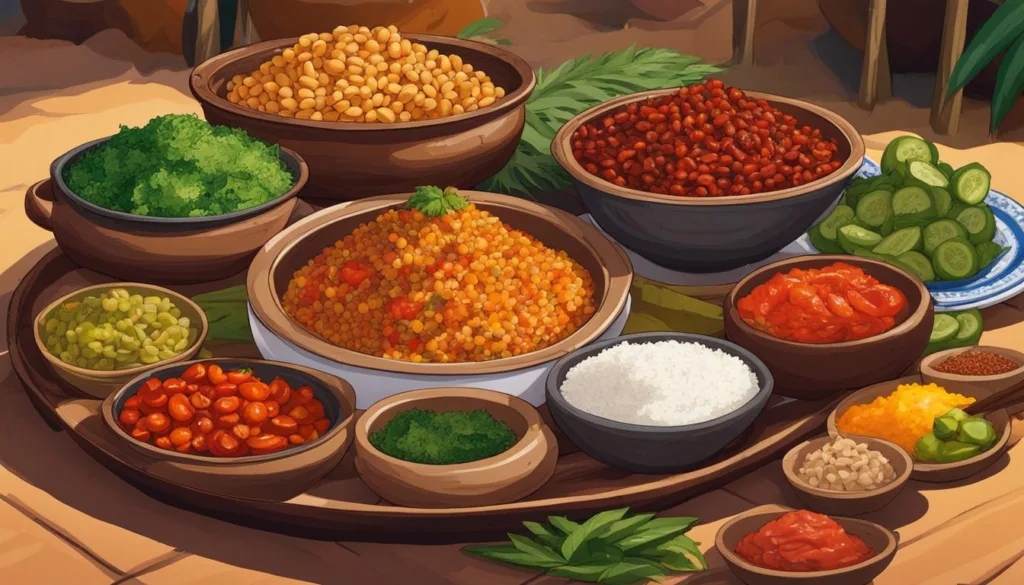
- Jollof Rice: The quintessential West African dish with a Guinea-Bissauan twist, deeply ingrained in the fabric of Guinea-Bissau food culture.
- Caldo de Peixe: A rich, flavorsome fish stew that speaks to the country’s coastal heritage and its mastery of seafood dishes.
- Cachupa: A hearty and comforting stew that epitomizes the communal spirit of Guinea-Bissau’s dining traditions.
- Pasteis de Massa Tenra: Savory pastries that offer a delectable quick bite, reflecting the simple yet profound pleasures of local street food.
- Queque: A sweet traditional cake that complements the vibrant savory dishes, rounding out the culinary exploration.
Whether joining locals in buzzing markets or sitting down at a quaint eatery, one can savor these culinary treasures and appreciate the true essence of Guinea-Bissau’s rich and diverse food scene. To further immerse into the gastronomic adventure, here’s a detailed checklist table for food lovers seeking the ultimate taste experience:
| Dish | Description | Typical Ingredients | Best Enjoyed At |
|---|---|---|---|
| Jollof Rice | Aromatic spiced rice dish simmered in a flavorful tomato sauce | Rice, tomatoes, onions, bell peppers, various spices | Local festivals and family gatherings |
| Caldo de Peixe | Sumptuous fish stew with a blend of exotic spices and vegetables | Fresh fish, tomatoes, okra, palm oil | Seaside restaurants and home kitchens |
| Cachupa | Hearty stew symbolizing unity, featuring corn, beans, and meat or fish | Hominy, beans, cassava, sweet potato, fish or meat | Local community feasts |
| Pasteis de Massa Tenra | Flaky pastries filled with savory mince | Wheat flour, butter, minced meat or vegetables | Street vendors and snack bars |
| Queque | Moist and fluffy cake often flavored with vanilla or coconut | Eggs, sugar, flour, butter, flavorings | Bakeries and afternoon tea spots |
Embarking on this culinary odyssey, travelers are sure to find joy in the authenticity and depth of Guinea-Bissau food culture. Each dish is a story of its own, alluring in taste and steeped in centuries-old traditions, ready to be discovered in the bustling best food spots Guinea-Bissau extends to those who visit.
The Fusion of Flavors: Guinea-Bissau’s Portuguese Culinary Influence
The luscious palette of Guinea-Bissau’s food culture is richly woven with threads of Portuguese heritage, weaving a tapestry of taste that spans centuries. From savory stews to aromatic seasonings, the Portuguese culinary influence in Guinea-Bissau is a testament to the enduring legacy of colonial cuisine and its lasting impact on the local gastronomy.
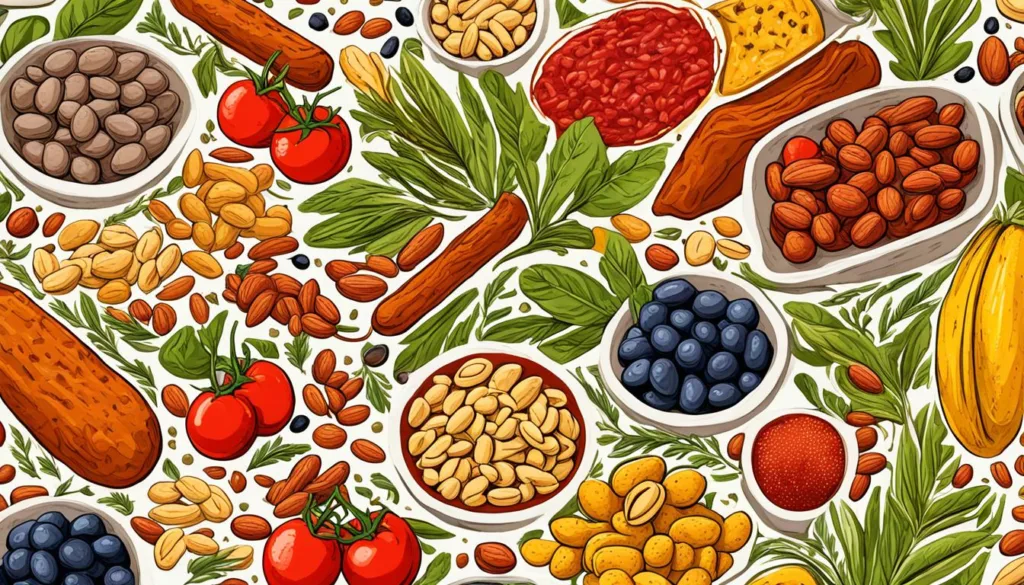
Colonial times brought more than just governance; they introduced a culinary revolution that still resonates within Guinea-Bissau’s kitchens and dining traditions. The fusion of Portuguese flavors with the country’s indigenous cooking practices created a new dimension of taste that endures in its modern-day culinary fabric.
Adopted Tastes: Portuguese Spices in Local Dishes
Guinea-Bissau’s cuisine doesn’t shy away from bold flavors, and this bravado can be attributed to the Portuguese culinary influence. The introduction of spices such as coriander, cinnamon, and piri-piri has given rise to an enriched food profile where each spice plays a key role. Additions like these have seamlessly blended into the core recipes of Guinea-Bissau’s food culture, giving the country’s dishes a distinctly Portuguese zest.
A Taste of History: The Legacy of Colonial Cuisine
The impact of Portuguese cuisine goes beyond ingredients—it’s steeped in history and tradition. The colonial period left behind more than just recipes; it left culinary customs that shaped the structure of meals, the choice of ingredients, and the methods of cooking, casting a long-lasting gastronomical spell over Guinea-Bissau. Even decades later, the colonial cuisine impact can be sensed, as it comfortably coexists with the pre-colonial traditions, symbolizing a cross-cultural dialogue that has come to define the nation’s culinary identity.
- Legacy of Portuguese stews and soups in Guinea-Bissau’s comfort meals
- Incorporation of rice and root vegetables from the Portuguese culinary script
- Lasting use of Portuguese-style marinated meats and seafood preparations
In the midst of globalization, Guinea-Bissau clings passionately to its culinary roots while paying homage to a history rich in flavors—where each dish tells a story and every spice paints a picture of a fusion that transcends time.
Where to Eat in Guinea-Bissau: From Street Food to Fine Dining
Embarking on a culinary quest in Guinea-Bissau offers an exciting spectrum of flavors that align with the heart and soul of its culture. Whether you’re craving quick bites on the go or prefer the elegance of a sit-down dinner, the country’s food landscape caters to every palate and occasion.
Savoring Street Food: The Pleasure of Pasteis de Massa Tenra
The streets of Guinea-Bissau serve as corridors to discovery, where the scent of Pasteis de Massa Tenra wafts through the air, enticing locals and tourists alike. These savory pastries are a must-try, exemplifying the nation’s culinary simplicity and love for deep-fried treats.
Discovering Guinea-Bissau’s Best Food Spots: A Local’s Guide
Finding the best food spots Guinea-Bissau has to offer often means listening to the locals, as they navigate toward the bustling markets or the hidden gems only those with insider knowledge frequent. Here, you’ll uncover a fusion of tastes, including the signature flavors of traditional Guinean dishes cooked to perfection.
| Cuisine Type | Experience | Recommended For |
|---|---|---|
| Street Food | Quick & Casual | Adventurous Foodies |
| Seafood Specialties | Ocean-to-Table Freshness | Seafood Enthusiasts |
| Fine Dining | Elegant & Refined | Special Occasions |
| Local Eateries | Homely & Comforting | Cultural Experience Seekers |
As part of the vibrant Guinea-Bissau food guide, it’s evident that whether you choose the simplicity of street snacks or the refinement of high-end restaurants, you are sure to encounter the authentic essence of Guinea-Bissauan hospitality and gastronomy. Prepare for a journey that not only fills the belly but enriches the soul with every bite taken in this West African haven of culinary diversity.
Inviting Fruits and Vegetables into Guinea-Bissau’s Cuisine
As an integral part of the Guinea-Bissau food guide, an exploration of the country’s local cuisine would be incomplete without mentioning the variety of fruits and vegetables that enrich its traditional recipes. The agricultural richness of Guinea-Bissau gifts its culinary practices with an array of colorful and nutritious produce, seamlessly blending into every meal and offering a taste of the nation’s natural bounty.
Tropical Fruits: A Sweet Highlight in Guinea-Bissau’s Food Culture
Tropical fruits are not just a mere side or dessert in Guinea-Bissau; they are essential flavors woven into the day-to-day fabric of eating. The sweetness of lush mangoes, the bright tang of papayas, and the juicy burst of oranges contribute to the refreshing palate present in the local cuisine in Guinea-Bissau. These fruits are often incorporated into smoothies, salads, or even savory dishes, creating a perfect balance for the richer, savory flavors that define the country’s gastronomy.
Vibrant Veggies: The Role of Agriculture in Traditional Meals
The fertile lands of Guinea-Bissau yield a diverse crop of vegetables that are artistic staples on the plate. Okra, with its unique texture, is a beloved component in stews and soups. Sweet potatoes provide a comforting sweetness and are a versatile ingredient in many traditional recipes Guinea-Bissau has to offer. These vegetables are not just sides but the stars of numerous dishes, reflecting the importance of agriculture and the pivotal role it plays in sustaining the country’s food traditions.
- Mangoes – a symbol of sweetness in drinks and desserts
- Papayas – adding a tropical zing to salads
- Oranges – infusing a citrus burst in meals and juices
- Okra – thickening stews with its gooey texture
- Sweet Potatoes – bringing heartiness to the table
Through the ardent support of its agriculture, Guinea-Bissau continues to honor its heritage by serving dishes rich in nature’s treats, keeping its food culture deeply rooted in the appreciation for the land’s vibrant and delicious offerings.
Guinea-Bissau on a Plate: The Pioneering Role of Cashews and Seafood
The culinary landscape of Guinea-Bissau is a vibrant tapestry woven with the rich threads of local ingredients, among which cashew nuts and seafood are particularly integral to the nation’s food identity. This blend of flavors not only typifies the Guinea-Bissau food culture but also showcases the ingenuity with which the people of this West African paradise have harnessed their natural resources.
The Cashew Curry Phenomenon
At the heart of the nation’s culinary innovation is the beloved cashew curry, a dish that has transcended Guinea-Bissauan borders to become a global fascination. Merging the creaminess of cashews with the warm embrace of spices, this dish is a testament to the creativity and simplicity of traditional cooking methods in Guinea-Bissau. It’s a flavorful celebration that turns the humble cashew into a luscious and aromatic delight.
Seafood Splendor: An Ocean’s Bounty on the Dinner Table
Seafood staples from Guinea-Bissau manifest the coastal essence of the country’s cuisine. Pristine Atlantic waters provide an array of catch that lands on dinner tables, illustrating the deep connection between the people and the sea. From sun-drenched lunches featuring grilled fish to festive gatherings centered around shrimp stews, the abundance of seafood is a cornerstone of daily life and a source of both sustenance and pleasure.
| Seafood Delicacy | Preparation Style | Occasion |
|---|---|---|
| Grilled Pargo | Seasoned with local spices and grilled over open flames | Casual family gatherings |
| Shrimp Stew | Simmered in a rich, tomato-based sauce with aromatic herbs | Festive celebrations |
| Percebes (Goose Barnacles) | Boiled in saltwater and served with a splash of lemon | Specialty culinary experiences |
Guinea-Bissau’s Culinary Icons: Top Dishes You Can’t Miss
Exploring the best of Guinea-Bissau’s culinary scene is an adventure for the senses, where every bite tells a story of tradition and taste. For food lovers and intrepid travelers alike, the local cuisine is an essential part of the journey, offering a flavorful tapestry woven from the country’s rich cultural heritage. Amidst the must-try dishes Guinea-Bissau offers, certain recipes stand out as culinary beacons, essential for experiencing the true essence of Guinea-Bissauan traditional recipes.
The Irresistible Complexity of Yassa Chicken
Yassa Chicken, a revered dish throughout Guinea-Bissau and neighboring West African countries, blends the zesty flavors of citrus with the savory depth of caramelized onions. This dish, notable for its complex layering of tastes, epitomizes the region’s preference for combining the fresh tang of marinades with hearty, spice-infused poultry. For an authentic Guinea-Bissau food guide, Yassa Chicken features prominently as the go-to choice for anyone eager to delve into the flavors that define the nation’s palate.
Hearty and Homely: Why Xerem and Funge Deserve Attention
Xerem and Funge are the unsung heroes of Guinea-Bissau cuisine. These dishes provide a hearty foundation to the vibrant stews and soups commonly found across the region. Xerem, a creamy cornmeal-based dish, pairs exquisitely with fish and meat stews, while Funge, a softer porridge often made from cassava flour, acts as the ideal complement to saucier dishes. They embody the warmth of home-cooking and wellness, deeply rooted in the nation’s culinary mindset, that makes them must-try dishes Guinea-Bissau proudly serves.
| Dish | Main Ingredients | Flavor Profile | Recommended Pairings |
|---|---|---|---|
| Yassa Chicken | Chicken, Lemons, Onions, Chili Peppers | Savory with bright citrus notes | Rice, Xerem, sweet plantains |
| Xerem | Cornmeal, Water, Salt | Mild and creamy | Fish or meat stews |
| Funge | Cassava flour, Water | Soft and neutral | Soups with rich, savory sauces |
In a landscape so diverse in flavors, these dishes are your landmarks on a culinary map. They not only represent the delicious diversity of Guinea-Bissau’s food guide but also the comforts of a home whose doors are always open, inviting you in to share a meal that’s prepared with history and served with heart.
Conclusion
As we wrap up our culinary tour, it’s clear that the food scene in Guinea-Bissau is as rich and layered as its history. The dishes we’ve discovered are more than just meals; they are vibrant narratives of resilience and a testament to the country’s enduring spirit. Our journey through the traditional recipes and local cuisine in Guinea-Bissau has not only given us a taste of the nation’s diverse gastronomy but also illuminated the ways in which community and culture are deeply woven into each bite.
Guinea-Bissau’s Food Scene: A Reflection of Resilience and Diversity
Through each spoonful of Jollof rice, every sip of Caldo de Peixe, and the multicultural symphony of spices, Guinea-Bissau’s culinary offerings reflect a society that has triumphed over adversity. The complexity of flavors encountered in the local cuisine in Guinea-Bissau stands as a testament to the resilience of its people, who have adapted their gastronomy to both honor tradition and embrace the evolution of their food culture. These authentic food experiences in Guinea-Bissau carry the essence of the country’s soul, inviting food lovers around the world to partake in its storied and delicious heritage.
Continuing Your Culinary Journey: What’s Next After Guinea-Bissau
Our foray into Guinea-Bissau’s gastronomy might have reached its conclusion, but the journey need not end here. The tapestry of West African cuisine is expansive, with countless other destinations offering equally authentic and captivating culinary delights. From the bustling marketplaces of Senegal to the historic cooking pots of Ghana, each locale beckons with its own unique flavors waiting to be savored. This Guinea-Bissau food guide is but a starting point, a prelude to the endless adventures that lie in wait for those eager to continue their exploration of West African food culture.
FAQ
What dishes are considered must-try in Guinea-Bissau?
Essential dishes include the beloved Jollof rice, Caldo de Peixe (fish stew), and Cachupa, a hearty stew of corn and beans. Sweets like Queque cake and street foods like Pasteis de Massa Tenra are also highly recommended.
Can you share some traditional recipes from Guinea-Bissau?
Yes, traditional recipes such as Caldo de Peixe, which is a savory fish stew simmered with local spices, and Cachupa, the national dish made with corn, beans, and a variety of meats, are integral to Guinea-Bissauan cuisine.
How significant is Portuguese influence on Guinea-Bissau’s cuisine?
Portuguese culinary influence is significant. It introduced spices and techniques during colonial times that have blended with local flavors and ingredients, enriching Guinea-Bissau’s gastronomy.
Where can one find the best food experiences in Guinea-Bissau?
You can find the best food experiences across various settings, from bustling street food markets serving Pasteis de Massa Tenra to fine dining establishments offering expertly prepared seafood and traditional dishes.
What role do fruits and vegetables play in Guinea-Bissau’s local cuisine?
Fruits like mangoes, papayas, and oranges, as well as vegetables like okra and sweet potatoes are essential in the local diet. They provide not only nutritional value but also balance to the rich and savory flavors of the cuisine.
What seafood dishes should I try in Guinea-Bissau?
The coastal geography of Guinea-Bissau means seafood is abundant. Grilled fish, shrimp dishes, and the ever-present Caldo de Peixe are among the seafood specialties not to be missed.
Is Jollof rice the same in Guinea-Bissau as it is in other West African countries?
While Jollof rice is a staple across West Africa, each country and even regions within those countries have their own variations. The Guinea-Bissau version of Jollof rice will have its own unique blend of spices and preparation techniques.
How are communal values reflected in the cuisine of Guinea-Bissau?
Many dishes in Guinea-Bissau are prepared and enjoyed communally. Cachupa, for example, is often served at large gatherings, symbolizing unity and shared culture.
Are there any plant-based dishes in Guinea-Bissau for vegetarians?
Yes, many dishes can be adapted for a vegetarian diet in Guinea-Bissau. The rich variety of tropical fruits, vegetables, and grains offers ample opportunities for plant-based meals.
What makes Guinea-Bissau’s food culture unique?
Guinea-Bissau’s food culture is unique due to its blend of West African, Portuguese, and indigenous influences, its communal approach to eating, and its use of local, fresh ingredients like cashews and seafood from the Atlantic.
